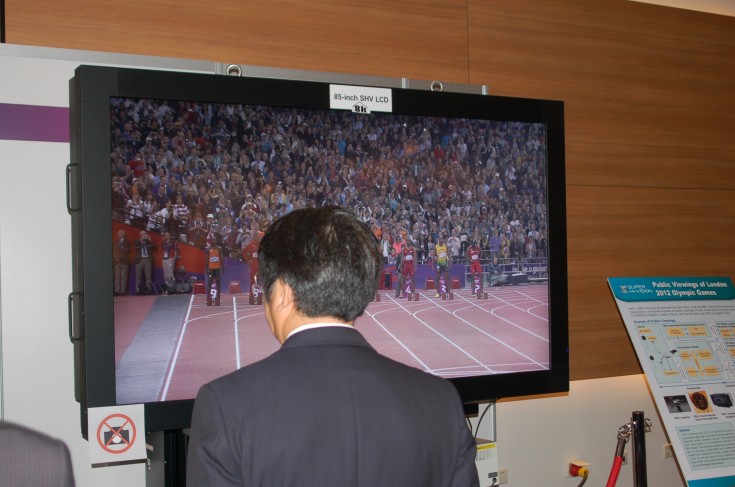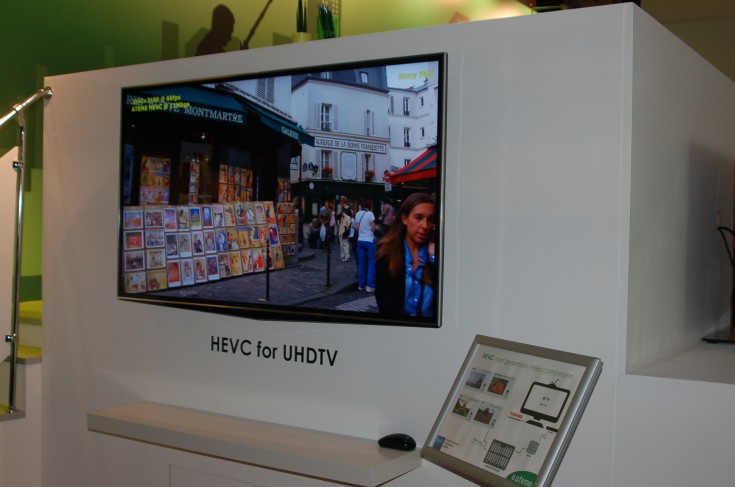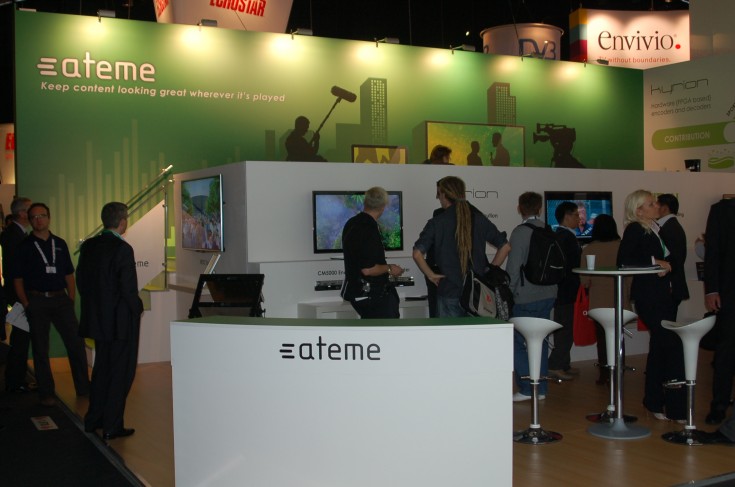(iTers News) - 4K TVs appear out of nowhere. The sudden arrival of the crystal-clear and sharper picture image technology prompts hypes as well as confusions about what and how the 4K TV market would shape up to be over the next 5 to 10 year period.
The 4K, ultra definition picture image technology is completely anew to the TV, movie and broadcasting industries all together. The only thing they know about the technology for sure is that it should carry 4 times more resolution than that of 2K full HD TVs, or more than 8 million pixels.
Yet, the 4K technology is not only all about exponential growth in the pixel numbers, or resolution, but also about color gamut, image frame rate, aspect ratio, color sampling, pixel bit depth, and audio quality.
Still, no common standard on those technology specifications are defined and certified, only fanning ill perceptions and misunderstandings.
Nor is an exact and clear definition on what resolution the next generation of beyond HD TV has to carry as well as on how to term it.
Mixed receptions
Some refers to it as 4KTV, claiming that it has to feature a resolution of 4096x2160p at 24Hz.
Meanwhile, ITU-R, or International Telecommunications Union Radio Communications sector defines 4KTV as UHDTV1 and 8KTV as UHDTV2, setting their resolution at 3840x2160p and 7680x4320p, respectively. The standard-setting body also stipulates that both of them must carry a 22.2 audio channel.
UHDTV stands for ultra-high definition TV.
More embarrassingly, it has been just 2 years after most of advanced countries like the U.S., Germany, the U.K., France, and Japan, just to name a few, turned to digital broadcasting system, switching off its analog airing.
Meanwhile, other less advanced countries in EU are still gearing up to shift from SD to HD broadcasting systems.
So, most of broadcasting stations are neither ready to embrace the new 4K technology, nor afford to invest in a new 4K broadcasting eco-system.
Hurry up toward 4K
Hard hit by demand saturation in matured TV markets, however, TV makers are in desperate need for a new growth catalyst to refuel years-long slow demand for TVs, trying to do everything to get back on solid growth track.
No to miss out on the potential, world top-tier TV makers like Sony, LG, Panasonic, and Toshiba all have aggressively lined up their respective 4K TV offerings in recent weeks across IFA 2012 and IBC 2012 trade shows.
LG said it would start to sell a 84-inch 4K TV in October, while Sony and Toshiba announced their plans to sell 84-inch 4K TVs in early 2013.
“In fact, this is great news for the industry, as current consumer demand is not fully satisfied with the first generation of HD TV. It also is important for Sony. It is also a next wave of change Sony is leading under our catchphrase of “Be beyond HD”, said Katsunori Yamanouchi, vice president and head of Sony Professional Solution Europe.
To tap into the yet-to-find 4K potential, Sony and European low-orbit satellite broadcasting service provider SES S.A. joined forces to test-run real-time live satellite 4K broadcasting service at IBC 2012 trade shown held from Sept 7 to 11 in Amsterdam, the Netherlands.
Shot in Betzdorf, Luxembourger with Sony’s F65 cinema 4K camera, the native 4K video pixel information was encoded at a bit rate of 50Mbps, or 50 megabits per second using H.264-based AVC, or advanced video coding, and was being live transmitted via SES’s low-orbit ASTRA satellite.
The compressed 4K content was going all the way through a broadcasting receiver set up in IBC show floor to Sony’s native 84-inch 4K Bravia TV on display at its booth floor.
SES S.A. is a low-orbit satellite service operator in Betzdorf, Luxembourger that operates a fleet of 51 geostationary satellites. It is operating more than 1,300 HD satellite channels.
With the availability of a future-proof HEVC, high efficiency video coding chipset sometime in 2013, which can compress a native 4K content at a bit rate of 20Mbps, SES bets a 4K satellite television will soon become a commercial reality. The targeting bit rate of 20Mbps is the equivalent compression rate of today‘s HD MPEG2.
Live 4K broadcasting service on the test-run
SES is looking forward to extending collaboration with Sony to start the regular real-time native 4K television service using its current radio spectrum capacity available now, which the company said is already big enough to carry 4K without suffering bandwidth crunch.
Not everybody is optimistic about the immediate commercial roll-out of 4K TV broadcasting services, however.
Skeptics are questioning the willingness of broadcasting stations, especially terrestrial and cable TV operators, to embrace the nascent, but potentially money-guzzling 4K television systems, given no preparation work has been done to create a 4K TV broadcasting ecosystem of hardware and software.
Rarely have they gotten any return on their huge investments in the migration to digital broadcasting system. 0- a nest egg to help finance their migration to 4K TV broadcasting system.
What most concerns the skeptics is a possible bandwidth crunch. As native 4K content carries more than 8 million pixels, transmitting uncompressed 4K images requires an enormously fat and wide bandwidth pipeline of 10-12Gbps, or gigabits per second.
Not to guzzle the limited bandwidth source of current digital terrestrial and cable network, the 4K audio and video pixel information has to be encoded, or compressed as much as possible to get transmitted at a current bit rate of HD 1080p picture by H.264 codec.
Yet, existing AVC, or advanced video codec technology is just able to transmit a 4K live video only at 3 times higher bit rate than that of HD, risking straining the bandwidth of the existing broadcasting network to the limit.
50% gain over AVC
Standard-setting bodies like JCT-VC have been working hard on a new generation of HEVC, or high efficiency video coding technology. The recent study result shows that HEVC gets about 50% gain over AVC in the data bit rate.
According to JCT-VC timetable, the first version of HEVC will be approved in January 2003, but the extended version for support of higher bit depth, color sampling beyond 4:2:0, stereo and multi-view features is expected to be released in early 2014.
Yet, it will take another couple of years before scalable extensions for hybrid capability and stereo and advanced 3D extensions are expected to be defined and released.
“HEVC will be a successor to H.264 and AVC, enabling 4K TV broadcasting with only 2 times current HD bit rate. Yet, it will be very difficult to build a native 4K broadcasting value chain within a year,” said Pierre Larbier, CTO with ATEME
ATEME is a Bievres, Paris, France-based video compression solution provider, mainly targeting MPEG2/MPEG4 and H.264/AVC codec technology. At IBC 2012, ATEME has dry-run a real-time transmission of a native 4K video from a source device to Toshiba’s 55-inch 4K TV at bit rate of 11-17 Mbps using its own HEVC encoding technology.
The commercial version of ATEME's HEVC encoding technology is scheduled to be rolled out in the third quarter of 2013.
ATEME CTO Pierre Larbier also pointed out that the industry straddles the fence on many technical standards about 4K TV. When it comes to color sampling and frame rate, for example, the industry does not yet decide where to go; 4:4:2 , or 4:4:4, and 50/60Hz or 100Hz/120Hz.
Off to a slow start
Echoing his view, Takashi Kurama, manager of marketing group with Professional AV business unit of Panasonic Corp. is also calling into question the immediate roll-out of the 4K TV broadcasting ecosystem.
He said, ““I think that it will take a couple of years before 4K TV market will have taken off, because there is few 4K content available now. Nor does get any of broadcasting stations ready to accommodate it.”
“TV makers, especially Japanese makers, are in a hurry to create 4K TV markets, because they need to revitalize TV demand out of its slump. The receiver sides of the 4K market like 4K TV and 4K movie theater is increasingly getting ripe for the take-off, but, if you look at the source sides like broadcasting stations and content providers, that‘s a quite different story,“ said Katsumasa Dohl, European Business Planning and Administration director with Canon Europe Ltd.
The contradictory and mixed picture about the 4K TV market helps explain why all players in the TV, movie studio and broadcasting industries are feeling confusion. It also offers a clue to how 4K TV market will evolve over the next 5 to 10 years.
As ATEME CTO Pierre Larbier puts it, “The cinema industry is moving toward the 4K”, the 4K market will come roaring up to get off the ground first around cinema studios and movie theaters
Cases in point: With the increasing availability of cinema 4K cameras like Sony’s F-65 and EX-FS700E, JVC’s GY-HMQ10, and RED’s Epic and Scarlet X, an increasing number of Hollywood studios are shooting many of movies at 4K.
Short on 4K content, TV makers will be making a way around to first form a 4K-ready TV market in the same way that they had ridden on demand for HD-ready TVs and other peripherals 10 years back into early 2000s to create a native HD market in mid-2000s.
As up-converter or upscale chips can convert full 2K content into 4K viewing experiences, TV makers will bet on 4K-ready source devices like Blu-Ray players and STBs to make up the 4K content scarcity.
TV makers are also expected to double a 4K TV as a most optimal display solution for watching glass-free 3D content to boost initial demand, as its over 8 million pixels are big enough to split images into 2 separate full-HD images for glass-free 3D full HD viewing experiences.




